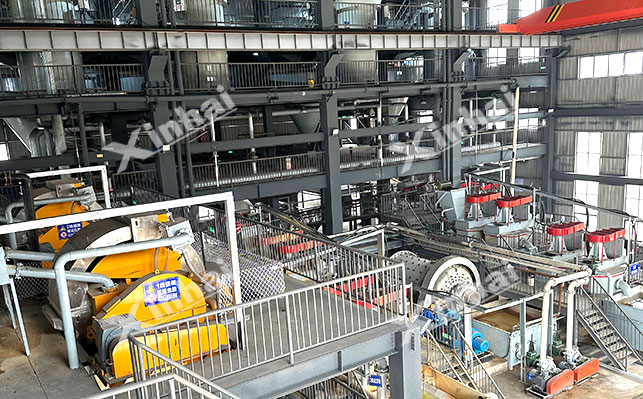
15311826613
Click to add WeChatManganese exists in various forms in ores, mainly in the form of manganese oxide, manganese carbonate and manganese silicate. It is not only an indispensable raw material in the steel industry, but also a raw material for batteries, paint desiccants, disinfectants, etc. Manganese oxide beneficiation methods vary according to the properties of the ore. The most common ones are washing, gravity separation, magnetic separation and flotation. However, since most of the manganese in my country is poor ore, some mines cannot obtain a more ideal manganese concentrate grade when only a single method is used, so a combined beneficiation process is formed through several combinations. Let's learn about it together!
Washing is a traditional method for manganese beneficiation. For manganese-rich ore, it can be directly washed and then smelted. In the washing process, vibrating screens are often used for direct washing, or the ore is washed first and then sent to the vibrating screen for screening. It usually takes two to three washings.

Gravity separation of manganese oxide mainly uses the density difference between manganese and gangue minerals for separation (generally, the density of manganese minerals is greater than that of gangue minerals). There are two types of gravity separation: jig gravity separation and shaking table gravity separation. The former is more suitable for processing coarse and medium-grained manganese oxide ores; shaking tables are more suitable for processing fine or micro-fine manganese oxide ores.

However, with the gradual depletion of rich manganese ore, low-grade manganese ore and refractory manganese ore cannot achieve the ideal grade by single gravity separation due to the complex intercalation of ore and the close intercalation between target minerals and gangue minerals. However, if the monomer dissociation degree between minerals is increased, manganese loss will occur. Therefore, gravity separation is often used in combination with other methods for refractory manganese, and gravity separation is used as a pre-selection operation.
Magnetic separation of manganese oxide minerals is due to the presence of weak magnetic minerals in manganese ore. Magnetic separation can remove magnetic impurities. It is mostly suitable for processing manganese ore with smaller particle size. During operation, strong magnetic magnetic separators (permanent magnetic roller strong magnetic separators, permanent magnetic high gradient strong magnetic separators, vertical ring high gradient strong magnetic separators) are often used for separation. Although the magnetic separation method has high cost in terms of infrastructure investment, it is generally low in consumption, simple to operate, and easier to maintain and control.

The characteristic of manganese oxide is that the mineral surface is easily wetted by water and has low floatability. Therefore, a single flotation method is not used for separation, and other methods are often combined to form a combined beneficiation method.
According to the properties of manganese oxide ore, the commonly used combined methods are gravity separation-magnetic separation method and magnetic separation-flotation method.
Gravity separation-magnetic separation method:For some low-grade manganese oxide, magnetic separation and gravity separation can be used. The magnetic separation uses a roller-type strong magnetic separator, and the gravity separation uses a jig. Although magnetic separation can obtain a higher manganese recovery rate, its concentrate grade is low; while gravity separation can obtain a higher concentrate grade. The two processes complement each other to obtain a more ideal manganese oxide concentrate.
Magnetic separation-flotation method:This combined process is mainly suitable for processing some targeted manganese oxide minerals. When conventional strong magnetic separation, gravity separation, flotation, etc. cannot obtain a good separation effect, the separation can be completed by strong magnetic-flotation + magnetization roasting process. Under the condition of magnetization roasting temperature of 900℃, roast for a certain period of time and then cool, and then perform magnetic separation and flotation operations to obtain the final manganese oxide concentrate.

The above are several commonly used process methods for manganese oxide ore. In actual ore dressing plants, in order to correctly select the process method and obtain an ideal return on investment, it is necessary to conduct ore dressing tests first, and design a suitable manganese oxide ore dressing method through experimental analysis to achieve the ideal recovery rate as much as possible.